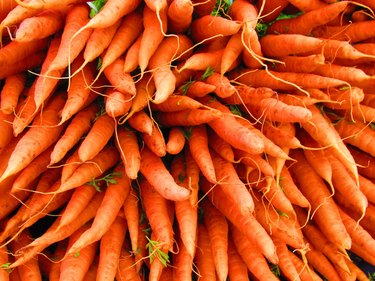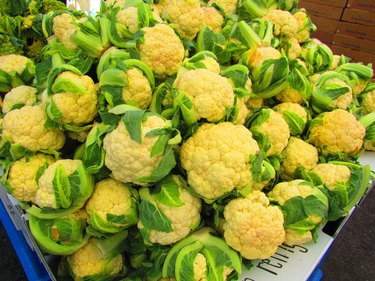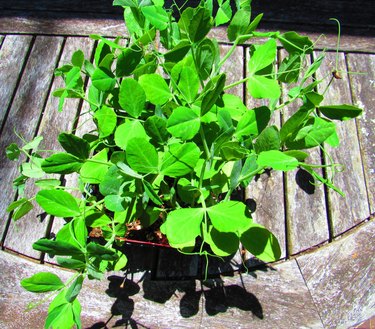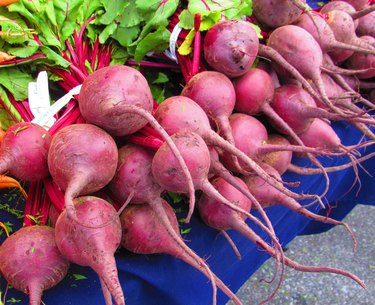
Have friends told you that you can't plant in your garden in midsummer? That it's too late? Wrong! If you missed installing a spring garden or just want to supplement your crops, early July is a great time to dive back in.
The key to succeeding with a midsummer garden is to select crops that will come to harvest in the remaining sunny days before the first frost. This will be a shorter period in the North and a longer one in the Pacific Northwest and the South.
Video of the Day
Video of the Day
So, don't hesitate — get ready, get outside, and get to planting!
Vegetables & Herbs to Plant in Midsummer
July is a very popular month for three good reasons: sun, sun, and more sun. The sun that makes the beach or pool so appealing also warms up the garden soil. So, unlike spring planting, you don't have to wait until the soil warms up to optimum germination temperatures.
The July weather makes your garden a warm, inviting spot for veggies, right up to the first frost. I used to think frost killed everything in the garden, but that's not true either. Yes, some tender vegetables die at the first mild frost. Others can survive a light frost but shrivel after a killing frost, while a third group shrugs off the cold and keeps on growing into winter. Plant a few of each!

Tender Warm-Season Veggies
Contemplating my July vegetable garden, I'm wishing I could put in those beefsteak tomatoes I didn't get around to installing in April. But it's not going to happen! Seed to harvest, these garden staples require some 85 days of sun. For a midsummer garden, we need to think tender, warm-season vegetables that will be ready to harvest before the first frost.
This midsummer group includes leafy greens like mustard greens (Brassica juncea), Swiss chard (Beta vulgaris var. cicla), spinach (Spinacia oleracea), and leaf lettuce (Lactuca sativa). These crops mature in 30 to 40 days, so try succession planting — planting seeds every few weeks to keep up a continuous harvest. At the end of the season, you can harvest and eat young leaves that are not fully mature as the cold weather arrives. They are delicious.
Another tender, warm-season crop is pole beans (Phaseolus vulgaris). These wilt at the slightest frost, so plant NOW and select a variety that requires no more than 60 days to maturity.
In terms of herbs, it's the time to plant basil (Ocimum basilicum) and cilantro (Coriandrum sativum) to harvest before the first frost.

Root Vegetables
Root vegetables are also good for midsummer since the edible parts are protected from heat and frost under the soil. That makes carrots (Daucus carota subsp. sativus), radishes (Raphanus sativus), and beets (Beta vulgaris) excellent choices for July planting. They survive a light frost. Parsnips will keep maturing even through a serious frost, so you can put them in as well. Keep in mind that you'll need to wait the four months it will take for them to be harvest-ready.

Cool-Weather Favorites
Cool-season vegetables are those that grow best in cooler weather, but that doesn't mean you can't get them started in July. Plant frost-hardy fall crops like broccoli (Brassica oleracea), bok choy (Brassica rapa subsp. chinensis), cabbage (Brassica oleracea), kale (Brassica oleracea var. acephala), turnips (Brassica rapa), cauliflower (Brassica oleracea), and peas (Pisum sativum). While some of these vegetables require more than 60 or 70 days to mature, all accept some frost.

How About Flowers?
Your perennials and many of your annuals may still be blooming in July, but if you want to augment the display, shop the sales. Many of the flowers remaining in the garden store will be on sale for a nice price. Buy whatever appeals to you. I personally love marigolds and petunias, both bright and cheerful and reputed to keep bugs away.

Tips for Midsummer Gardening
I learned these tips through trial and error — many errors! You may be able to avoid the mistakes I made by taking these to heart:
- Determine the average date of the first light frost and the first killing frost in your area —
not just your state but your neighborhood. The local university extension can probably help with this, or try the local garden store. These are essential dates to have in mind when you are putting in a midsummer garden.
- You'll also want to list the days to maturity for the crops you are considering. I've included my favorites in a table below. Using this and the first frost date, you can determine whether you have time to grow that crop.
- Consider veggie starts instead of seeds. You have to pay more, but you are also buying time, maybe even three weeks. I admit to largely using starts in midsummer. This also helps when you are planting vegetables that don't easily germinate seeds in hot soil, like lettuce.
- Don't just dig holes in the soil you last worked in spring. Remove all debris and weeds before planting. Then, turn over the soil, add some nutrients, and work those in as well.
- Summer-planted veggies will need water, so give them ample irrigation. Don't try to make them drought-tolerant! This mistake will be reflected in their taste and texture.
- Adding organic mulch to your garden beds will hold in the water and prevent weeds. I like straw or shredded leaves.
- My midsummer lettuce bolted and turned so bitter that I had to compost it. If you want to include lettuce in your July garden, plant it in the shade of taller plants.

Vegetables for July Planting
Vegetable | Days to harvest | Frost-tolerant |
|---|---|---|
Basil | 30–60 | No |
Beets | 50–60 | Light frost |
Bush beans | 45–65 | No |
Broccoli | 50–70 | Yes |
Cabbage | 50–90 | Yes |
Cauliflower | 60–80 | Light frost |
Carrots | 50–100 | Yes |
Cilantro | 60–70 | No |
Collard greens | 40–65 | Yes |
Kale | 40–65 | Yes |
Leaf lettuce | 40–60 | Light frost |
Mustard greens | 30–40 | Light frost |
Peas | 70–80 | Light frost |
Radishes | 30–60 | Light frost |
Spinach | 35–45 | Light frost |
Swiss chard | 40–60 | Light frost |
Turnips | 50–60 | Yes |
